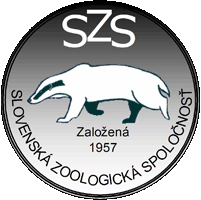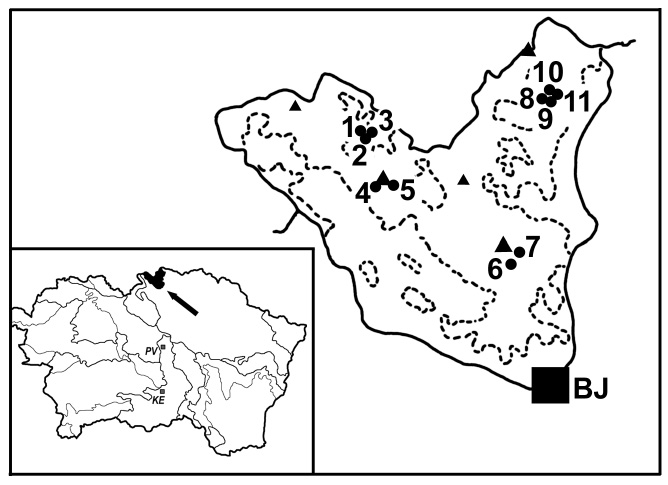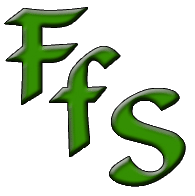Folia faunistica Slovaca 21 (3) 2016: –220
Faunistic records of Slovak oribatids II.
Oribatid mites (Acarina) of BUSOV
Mountains, North-East Slovakia
Ladislav Miko
Faculty of Environmental Sciences, Czech University of Life Sciences Prague, Kamycka 1176, CZ–16521 Prague, Czech Republic [LadislavMiko@seznam.cz]
Faculty of Science, Institute of Environmental Studies, Charles University in Prague, Albertov 6, CZ–12843 Praha 2, Czech Republic
Abstract: Oribatid fauna of selected localities in Busov Mountains was studied. Altogether, 114 species of oribatid mites from 36 families were found in 11 qualitative samples from years 1988 and 1990. Hydrozetes lemnae (Coggi, 1899) is recorded for the first time from the territory of Slovakia. Cultroribula confinis Berlese, 1908 and Oribatella brevipila Bernini, 1977 known until now only from Pieniny are recorded for the second time from Slovakia.
Key words: faunistics, Busov Mountains, soil oribatid mites, new species for the fauna, East Slovakia.
Introduction
Busov Mountains is a small mountain unit in north-eastern Slovakia, belonging to the Nízke Beskydy (Low Beskid) Mountain range, part of Outer Eastern Carpathians. The mountains reach elevations up to 1002 m (Mt. Busov).
Territory of Busov Mountains was never researched for oribatid mites. However, some information is available from other parts of Slovak Eastern Carpathians. Few species are known from adjacent ranges, such as Ondavská vrchovina and Nízke Beskydy – Bukovské vrchy – Poloniny range, from unpublished work of Kunst (1968). Broader information about oribatids was published by Miko (1987) from closely adjacent, western part of Nízke Beskydy. Comprehensive study is available also from not very remote area of Pieniny national park and from Jarabinský prielom natural reserve (Miko 2011).
Present paper brings first information about oribatid fauna of Busov Mountains, based on few ad-hoc taken samples from highest parts of the range, complemented by samples from swampy areas and peat-bogs in the valleys (Cigeľka, Regetovka).
Material and Methods
Qualitative samples were taken in years 1988 and 1990 in the sites and from habitats as indicated in overview below and indicated on Fig. 1. Samples were extracted in modified Berlese-Tullgren apparatus for one week. Extracted material was fixed in 75% alcohol, and for further study macerated in lactic acid. Part of determined material is kept in collection of the author, remaining material is stored in the collection of Faculty of Sciences of Pavel Josef Šafárik University in Košice (Ľ. Kováč). Large part of the material was however lost in the past moves. This did not allow re-determining the species which were originally determined only to genus level (Phthiracarus spp.). For taxonomy of species, the approach of Weigmann (2006) was followed with some minor adjustments.
List of analysed samples
1 Sample LM-124-90. Cigeľka, litter and upper soil layer from mixed forest (Fagus, Acer, Betula). 21.6.1990, Ladislav Miko lgt.
2 Sample LM-128-90. Cigeľka, moist litter from mixed forest (Fagus, Acer, Corylus, Betula). 21.6.1990, Ladislav Miko lgt.
3 Sample LM-129-90. Cigeľka, litter and upper soil layer from beech forest (Fagus) near the small water stream. 21.6.1990, Ladislav Miko lgt.
4 Sample LP-04-88. Busov (1002 m), north-west slope, beech forest with maple admixture (Fagus, Acer), mosses from rotting stumps. 4.9.1988, Ľubomír Panigaj lgt.
5 Sample LP-05-88. Busov (1002 m), north slope under the top, litter and soil from beech forest with maple admixture (Fagus, Acer). 4.9.1988, Ľubomír Panigaj lgt.
6 Sample LP-03-88. Stebnícka Magura (900 m), north slope, litter and soil from fir-beech forest (Abies, Fagus). 4.9.1988, Ľubomír Panigaj lgt.
7 Sample LP-01-88. Stebnícka Magura (900 m), top of the mountain, litter and soil from fir-beech forest (Abies, Fagus). 4.9.1988, Ľubomír Panigaj lgt.
8 Sample LM-303-88, LM-304-88, LM-125-90 and LM-126-90. Regetovka peat-bog. Wet Sphagnum, with other mosses, Drosera, Carex and Juncus in central part of peat bog. 20.8.1988 and 21.6.1990, Ladislav Miko lgt.
9 Sample LM-306-88 and LM-307-88. Regetovka peat-bog. Litter, mosses and upper soil layer from alder growth (Alnus) in upper part of peat bog. 20.8.1988, Ladislav Miko lgt.
10 Sample LM-305-88. Regetovka peat-bog. Eutrophic grassland at the southern margin of peat-bog with Urtica and Rumex, very wet. 20.8.1988, Ladislav Miko lgt.
11 Sample LM-308-88, LM-122-90 and LM-123-90. Regetovka peat-bog. Litter and upper soil layer from beech forest (Fagus) on the margin of peat-bog. 20.8.1988 and 21.6.1990, Ladislav Miko lgt.
Results
Altogether, 111 taxons of oribatid mites from 36 families were identified in Busov Mountains. As under Phthiracarus sp. there are at least 4 different species referred to, overall number of found species is 114. All of the species are first time recorded from this particular part of Slovakia, and one species – Hydrozetes lemnae (Coggi, 1899) was not yet recorded from Slovakia and represent new species for Slovak fauna. Cultroribula confinis Berlese, 1908) and Oribatella brevipila Bernini, 1977 are only known from Pieniny and the finding represents second record for Slovak fauna. The species found are in following list.
List of oribatid species found
For each species, the locality is given by number code corresponding with numbering in overview of samples above. Number of determined individuals is given for each sample in parentheses. This number does not necessarily corresponds to all individuals in sample, which may be higher than given (the numbers were counted only partly, as all samples were qualitative and not quantitative). Species first time recorded from territory of Slovakia is indicated by asterisk (*).
Brachychthoniidae
1. Liochthonius muscorum Forsslund, 1964 – 8 (4)
2. Liochthonius sellnicki (Thor, 1930) – 6 (1)
Hypochthoniidae
3. Hypochthonius rufulus C. L. Koch, 1835 – 8 (2)
Eulohmaniidae
4. Eulohmannia ribagai (Berlese, 1910) – 11 (1)
Phthiracaridae
5. Phthiracarus globosus (C. L. Koch, 1841) – 4 (1); 9 (2)
6. Phthiracarus peristomaticus Willmann, 1948 – 6 (1)
7. Phthiracarus spp. (4 species) – 4 (8); 5 (1); 7 (1); 11 (1)
8. Steganacarus spinosus (Sellnick, 1920) – 8 (2)
Euphthiracaridae
9. Euphthiracarus monodactylus (Willmann, 1919) – 2 (1)
Malaconothridae
10. Malaconothrus monodactylus (Michael, 1888) – 3 (1)
11. Trimalaconothrus foveolatus Willmann, 1931 – 8 (3)
12. Trimalaconothrus maior (Berlese, 1910) – 8 (13)
Nothridae
13. Nothrus palustris C. L. Koch, 1839 – 2 (1)
14. Nothrus silvestris Nicolet, 1855 – 11 (3)
Camisiidae
15. Platynothrus (s. str.) peltifer (C. L. Koch, 1839)
– 4 (2); 5 (1) ; 9 (5); 10 (2)
16. Platynothrus (Capillonothrus) thori (Berlese, 1904) – 8 (1); 10 (1)
Nanhermanniidae
17. Nanhermannia coronata Berlese, 1913 – 8 (2)
18. Nanhermannia nana (Nicolet, 1855) – 11 (2)
Damaeidae
19. Belba bartosi Winkler, 1955 – 1 (4); 2 (1)
20. Belba corynopus (Hermann, 1804) –5 (1); 6 (2); 11 (1)
21. Damaeobelba minutissima (Sellnick, 1920) – 4 (1)
22. Damaeus riparius Nicolet, 1855 – 12 (2)
23. Metabelba papillipes (Nicolet, 1855) – 11 (1)
24. Metabelba pulverosa Strenzke, 1953 – 2 (4); 4 (1); 5 (15)
Ameridae
25. Amerus polonicus Kulczynski, 1902 – 2 (2)
Eremaeidae
26. Eremaeus hepaticus C. L. Koch, 1835 – 2 (3); 3 (10); 5 (10); 11 (1)
Zetorchestidae
27. Zetorchestes falzonii Coggi, 1898 – 2 (1)
Microzetidae
28. Microzetes septentrionalis (Kunst, 1963) – 11 (1)
Astegistidae
29. Cultroribula confinis Berlese, 1908 – 7 (1)
30. Cultroribula bicultrata (Berlese, 1905) – 11 (1)
Peloppiidae
31. Ceratoppia bipilis (Hermann, 1804) – 2 (2); 3 (1); 4 (1)
32. Ceratoppia quadridentata (Haller, 1882) – 1 (1); 4 (1); 11 (1)
Carabodidae
33. Carabodes coriaceus C. L. Koch, 1835 – 5 (2); 11 (1)
34. Carabodes femoralis (Nicolet, 1855) – 4 (7)
35. Carabodes rugosior Berlese, 1916 – 4 (5)
Tectocepheidae
36. Tectocepheus minor Berlese, 1903 – 6 (1); 7 (7)
37. Tectocepheus velatus alatus Berlese, 1913 – 7 (3)
38. Tectocepheus velatus sarekensis Trӓgårdh, 1910 – 1 (4); 3 (3); 9 (11); 10 (3)
39. Tectocepheus velatus velatus (Michael, 1880) – 1 (6); 2 (3); 11 (2)
Quadroppiidae
40. Quadroppia maritalis Lions, 1982 – 2 (2); 6 (1); 11 (1)
41. Quadroppia monstruosa Hammer, 1979 – 5 (8)
42. Quadroppia quadricarinata (Michael, 1885) – 4 (1); 11 (2)
Oppiidae
43. Berniniella bicarinata (Paoli, 1908) – 5 (4); 8 (1); 11 (1)
44. Berniniella conjuncta (Strenzke, 1951) – 2 (1)
45. Berniniella hauseri (Mahunka, 1974) – 9 (2)
46. Berniniella sigma (Strenzke, 1951) – 4 (2); 11 (2)
47. Dissorhina ornata (Oudemans, 1900) – 3 (4); 5 (1); 8 (1); 11 (1)
48. Microppia minus (Paoli, 1908) – 2 (4)
49. Multioppia glabra (Mihelčič, 1955) – 1 (2); 2 (6); 7 (1); 11 (4)
50. Oppiella (s. str.) marginedentata (Strenzke, 1951) – 1 (2); 2 (7); 4(4); 5 (1); 11 (7)
51. Oppiella (s. str.) nova (Oudemans, 1902) – 1 (7); 2 (5)
52. Oppiella (s. str.) uliginosa (Willmann, 1919) – 8 (34); 9 (3)
53. Oppiella (s. str.) sp. – 4 (1)
54. Oppiella (Rhinoppia) loksai (Schalk, 1966)
– 2 (2); 11 (3)
55. Oppiella (Rhinoppia) nasuta (Moritz, 1965) – 11 (1)
56. Oppiella (Rhinoppia) subpectinata (Oudemans, 1920) – 4 (14); 5 (4); 6 (1); 7 (1)
57. Oppiella (Rhinoppia) sp. – 11 (4)
Suctobelbidae
58. Suctobelba altvateri Moritz, 1970 – 11 (3)
59. Suctobelba discrepans Moritz, 1970 – 11 (1)
60. Suctobelba granulata van der Hammen, 1952
– 1 (2); 2 (1)
61. Suctobelba lapidaria Moritz, 1970 – 4 (5)
62. Suctobelba reticulata Moritz, 1970 – 4 (5); 11 (2)
63. Suctobelba secta Moritz, 1970 – 11 (1)
64. Suctobelbata prelli (Mӓrkel et Meyer, 1958) – 4 (2); 11 (1)
65. Suctobelbella acutidens (Forsslund, 1941)
– 1 (3); 2 (14); 4 (6); 5 (9); 6 (2); 7 (3); 11 (1)
66. Suctobelbella arcana Moritz, 1970 – 4 (8); 6 (2); 7 (1)
67. Suctobelbella carcharodon (Moritz, 1966) – 5 (2)
68. Suctobelbella similis (Forsslund, 1941) – 2 (1)
69. Suctobelbella subcornigera (Forsslund, 1941)
– 1 (12); 2 (4); 5 (4); 11 (4)
Autognetidae
70. Conchogneta dalecarlica (Forsslund, 1947)
– 1 (7); 2(1); 8 (1); 11 (3)
Thyrisomidae
71. Oribella pectinata (Michael, 1885) – 32 (1); 11 (1)
72. Pantelozetes paolii (Oudemans, 1913) – 11 (2)
Hydrozetidae
73. *Hydrozetes lemnae (Coggi, 1899) – 9 (1)
Scutoverticidae
74. Scutovertex minutus (C. L. Koch, 1835) – 9 (2)
Phenopelopidae
75. Eupelops occultus (C. L. Koch, 1835) – 10 (1)
76. Eupelops plicatus (C. L. Koch, 1835) – 3 (3); 11 (1)
Achipteriidae
77. Achipteria coleoptrata (Linné, 1758) – 4 (11); 5 (4); 10 (1)
78. Anachipteria deficiens Grandjean, 1932 – 1 (2); 2 (27); 3 (1); 4 (61); 5 (1)
Oribatellidae
79. Oribatella brevipila Bernini, 1977 – 1 (4); 2 (3)
80. Oribatella calcarata (C. L. Koch, 1835) – 1 (1); 3 (1); 11 (2)
81. Oribatella quadricornuta Michael, 1880 – 9 (1)
82. Oribatella dudichi Willmann, 1938 – 4 (2); 5 (2); 11 (3)
Galumnidae
83. Acrogalumna hungarica (Willmann, 1938) – 8 (5)
84. Acrogalumna longipluma (Berlese, 1904) – 4 (3)
85. Galumna obvia (Berlese, 1915) – 10 (1); 11 (1)
86. Galumna sp. – 5 (9)
87. Pergalumna altera (Oudemans, 1915) – 2 (1)
88. Pergalumna formicaria (Berlese, 1914) – 4 (3); 6 (1)
Ceratozetidae
89. Ceratozetes gracilis (Michael, 1884) – 2 (1); 4 (17)
90. Ceratozetes peritus Grandjean, 1951 – 7 (2); 11 (1)
91. Diapterobates humeralis (Hermann, 1804) – 9 (1)
92. Melanozetes mollicomus (C. L. Koch, 1839) – 3 (3); 4 (14)
93. Sphaerozetes piriformis (Nicolet, 1855) – 4 (17); 9 (1)
Chamobatidae
94. Chamobates borealis (Trӓgårdh, 1902) – 3 (15); 4 (24); 5 (95); 6 (1); 9 (1); 11 (1)
95. Chamobates cuspidatus (Michael, 1884) – 3 (3); 8 (2)
96. Chamobates spinosus Sellnick, 1928 – 2 (1); 4 (2)
97. Chamobates voigtsi (Oudemans, 1902) – 1 (12); 2 (37); 3 (12); 6 (2); Rb; 11 (7)
Mycobatidae
98. Minunthozetes pseudofusiger (Schweizer, 1922) – 2 (1); 3 (1); 4 (65); 5 (38); 6 (9); 7 (2)
99. Minunthozetes semirufus (C. L. Koch, 1841)
– 8 (2); 9 (1)
100. Punctoribates punctum (C. L. Koch, 1839) – 2 (4); 4 (14); 5 (4)
Euzetidae
101. Euzetes globulus (Nicolet, 1855) – 1 (1); 10 (1)
Parakalummidae
102. Neoribates aurantiacus (Oudemans, 1914) – 11 (1)
103. Neoribates neglectus Willmann, 1953 – 5 (4)
Scheloribatidae
104. Scheloribates (Hemileius) initialis (Berlese, 1908) – 5 (1)
105. Scheloribates (s. str.) fimbriatus Thor, 1930 – 8 (2)
106. Scheloribates (s. str.) labyrinthicus Jeleva, 1962 – 10 (1)
107. Scheloribates (s. str.) laevigatus (C. L. Koch, 1836) – 8 (6); 10 (5)
Oribatulidae
108. Oribatula tibialis (Nicolet, 1855) – 2 (11); 4 (1)
109. Oribatula pannonica Willmann, 1949 – 10 (1)
110. Oribatula sp. – 9 (1)
111. Zygoribatula exilis (Nicolet, 1855) – 6 (1)
Discussion
The finding of Hydrozetes lemnae (Coggi, 1899), recorded here for the first time from Slovak territory, is remarkable. The species is living in submerse vegetation in swamps and peat-bogs, and even if in the places of its presence may be rather abundant, it is found only locally. Species Cultroribula confinis Berlese, 1908 reported from Slovakia first time from Pieniny mountains (Miko 2011), is known more from southern part of Europe, but was found in the Czech Republic as well (Kunst 1968). As the species seems to prefer xerotherm habitats, its finding in fir-beech forest located at higher elevation of Busov was not expected. On the other hand, it may not be preferring necessarily warm climate, but rather dry and well insulated patches in the free landscape, which are present also in this part of Slovakia. Also Oribatella brevipila Bernini, 1977 was first time found in Pieniny mountains (Miko 2011). However, this species may be expected in Slovakia from more places as it is assumed that it was earlier not distinguished from similar species, particularly it could have been misidentified as Oribatella quadricornuta Michael, 1880.
High representation of species from superfamily Oppioidea is known from all parts of Slovak Eastern Carpathians, and is most probably linked to still rather broad presence of well-preserved beech forests in the region. Particularly interesting is finding of high number of closely related species of the genus Suctobelba (6 species).
As overall number of ad-hoc taken samples was quite low, presence of 114 species indicates a species-rich oribatid community and potentially high conservation value of studied habitats.
Acknowledgement
The author is grateful to his former colleague Dr. Ľubomír Panigaj (from P. J. Šafárik University, Košice) for collecting and providing samples from Stebnícka Magura.
References
Kunst M, 1968: Pancířníci nadřádu Oribatei Československa. Unpubl. habilitation thesis. Deposited in the Zoological library of the Faculty of Science, Charles University Prague, 1355 pp.
Miko L, 1987: Pancierniky (Acari: Oribatei) vybraných lokalít západnej časti CHKO Východné Karpaty.
X. Východoslovenský TOP (Krajná Bystrá, 1986), Prehľad odborných výsledkov, pp. 49–64.
Miko L, 2011: Oribatid mites (Acarina: Oribatida) of Pieniny national park and Jarabinský prielom nature reserve, North-East Slovakia. Folia faunistica Slovaca, 16 (1): 55–66.
Weigmann G, 2006: Hornmilben (Oribatida). Die Tierwelt Deutschlands Begründet 1925 von Friedrich Dahl, Teil 76., Goecke & Evers, Keltern, 520 pp.
Miko L, 2016: Faunistic records of Slovak oribatids II. Oribatid mites (Acarina) of Busov Mountains, North-East Slovakia. Folia faunistica Slovaca, 21 (3): –220.
[in English]
Received 8 April 2016 ~ Accepted 14 May 2016 ~ Published 19 December 2016
© Faunima, Bratislava, 2016
e–ISSN 1336–4529 ISSN 1335–7522


Figure 1. Schematic map of Busov Mountains (East Carpathians, Slovakia), with indication of sampling sites. Numbers of sampling sites correspond to those in Material and Methods. Dashed line indicates limits of forested areas, black triangles indicate highest peaks. BJ – town of Bardejov.
Miko L.: Oribatid mites of Busov Mts
Folia faunistica Slovaca 21 (3) 2016: 217–220
Miko L.: Oribatid mites of Busov Mts
